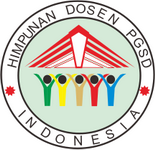Penerapan Pendekatan Pembelajaran Active Deep Learner Experience Dalam Membangun Kemandirian Belajar Siswa Sekolah Dasar
DOI:
https://doi.org/10.31949/jee.v6i3.6638Abstract
Student learning independence is an important component in achieving learning success. However, student learning independence in schools is still not optimal so it is necessary to take a supportive learning approach, namely active deep learner experience. The purpose of this study is to analyze the application of the ADLX learning approach in building student learning independence in elementary schools. This research is a qualitative research with descriptive method. Data collection techniques through interviews, observation, and documentation. The data analysis technique uses an interactive analysis model consisting of three steps, namely data reduction, data presentation and conclusion drawing. The data validity test used triangulation of data sources. The results of the study suggest that the application of the active deep learner experience approach through individualization, interaction, observation, and reflective aspects, and is able to build student learning independence but in the aspects of interaction and individualization the application is still limited to a few students. Thus, the active deep learning experience approach can help foster student learning independence.
Keywords:
active deep learner experience, learning independence;, elementary school studentsDownloads
References
Aziz, R. A. (2022). Manajemen Kurikulum Berorientasi Adlx (Active Deep Learner Experience) Dengan Pendekatan ‘Terpadu’ Terhadap Pembelajaran. Universitas Negeri Sunan Gunug Jati Bandung.
Bahgat, M., Elsafty, A., Shaarawy, A., & Said, T. (2018). FIRST Framework Design and Facilitate Active Deep Learner eXperience. Journal of Education and Training Studies, 6(8), 123. https://doi.org/10.11114/jets.v6i8.3337
Bahgat, M., Elsafty, A., Sharawy, A., Elsamman, K., Samir, R., & Said, T. (2017). Facilitating Active Deep Learner eXperience, Using FIRST Framework Transforming Role of Teacher in the Classroom. Icie, 21–23.
Bunandar, S. dan E. A. (2016). Analisis Kemandirian Belajar Siswa Pada Mata Pelajaran Biologi di kelas X MAS Al Mustaqim Kubu Raya. Unmuhpnk.http://repository.unmuhpnk.ac.id//
Fahmi, Z. (2013). Indikator Pembelajaran Aktif Dalam Konteks Pengimplementasian Pendekatan Pembelajaran Aktif, Kreatif, Efektif, Dan Menyenangkan (Pakem). Al-Ta Lim Journal, 20(1), 278–284. https://doi.org/10.15548/jt.v20i1.2
Famsah, S. (2023). Pengembangan bahan ajar teks prosedur berbasis web dengan desain pembelajaran Active Deep Learner Experience (ADLX) pendekataan terpadu pada siswa kelas VII SMPIT Al Uswah Bangil. UNISMA Repository. http://repository.unisma.ac.id/handle/123456789/6634
Hamruni. (2012). Strategi pembelajaran. Insan Madani
Lailie, N., & Dewi, G. K. (2022). Pengaruh pembelajaran Active Deep Leaner Experience (ADLX) terhadap hasil belajar siswa SDIT Permata Mulia Mojokerto. JPDI (Jurnal Pendidikan Dasar …, 7(1), 22–25. https://journal.stkipsingkawang.ac.id/index.php/JPDI/article/view/3064
Novianto, A., & Mustadi, A. (2015). Analisis Buku Teks Muatan Tematik Integratif, Scientific Approach, dan Authentic Assessment Sekolah Dasar. Jurnal Kependidikan, 45(1), 1–15.
Full article: Grit, self-efficacy, achievement orientation goals, and academic performance in University students. (n.d.). Retrieved September 15, 2023, from https://www.tandfonline.com/doi/full/10.1080/02673843.2019.1679202
Indah, R. P., & Farida, A. (2021). Pengaruh Kemandirian Belajar Siswa Terhadap Hasil Belajar Matematika. Jurnal Derivat: Jurnal Matematika Dan Pendidikan Matematika, 8(1), Article 1. https://doi.org/10.31316/j.derivat.v8i1.1641
McEachen, J. (2017). Assessment for Deep Learning. The New Pedagogies for Deep Learning (NPDL): Global Partnership, August(4), 1–16.
Nugrahani, F. (2014). Metode Penelitian kualitatif dalam penelitian pendidikan bahasa.
Saldana., M. & H. (2014). Qualitative Data Analysis. Sage.
Unaenah, E., Hidyah, A., Aditya, A. M., Yolawati, N. N., Maghfiroh, N., Dewanti, R. R., Safitri, T., & Tangerang, U. M. (2020). Teori Brunner Pada Konsep Bangun Datar Sekolah Dasar. Jurnal Pendidikan Dan Ilmu Sosial, 2(2), 327–349.
Salima, H. (2019). Analisis Kemandirian Belajar Siswa Dalam Pembelajaran Tematik di Kelas 2 SDI Al-AZHAR 17 Bintaro. Skripsi, 1–184.
Samian, N. I. dan. (2015). Kemandirian Belajar ditinjau dari Kreativitas belajar dan Motivasi Belajar mahasiswa. Pendidikan Ilmu Sosial, 129. https://journals.ums.ac.id/index.php/jpis/article/view/825
Santos, R. J. dos and D. G. G. S. (2015). An active learning methodology to teaching mechanics in youth and adult education. https://doi.org/https://doi.org/10.1590/S1806-1117373195
Subroto, S. (2009). Proses Belajar Mengajar di Sekolah. Rhineka Cipta.
Suhendri, H. (2012). Pengaruh Kecerdasan Matematika-Logi, Rasa Percaya Diri, dan Kemandirian Belajar terhadap Hasil Belajar Matematika. Formatif 1 Universitas Indraprasta PGRI.
T.P.K. P., & JSIT. (2021). Desain Pembelajaran Berbasis ADLX dengan Pendekatan Terpadu.
Trianto. (2010). Mengembangkan Model pembelajaran Tematik (pertama). Prestasi Pustaka.
Unaenah, E., Hidyah, A., Aditya, A. M., Yolawati, N. N., Maghfiroh, N., Dewanti, R. R., Safitri, T., & Tangerang, U. M. (2020). Teori Brunner Pada Konsep Bangun Datar Sekolah Dasar. Jurnal Pendidikan Dan Ilmu Sosial, 2(2), 327–349. https://ejournal.stitpn.ac.id/index.php/nusantara












